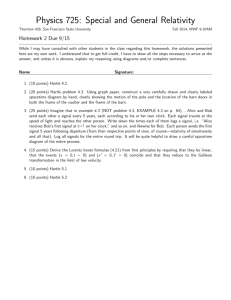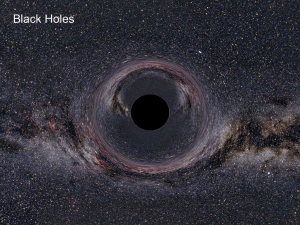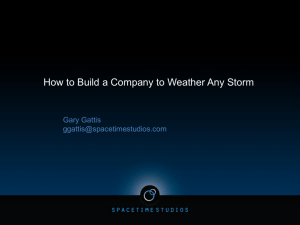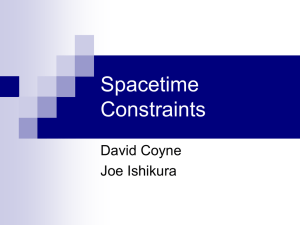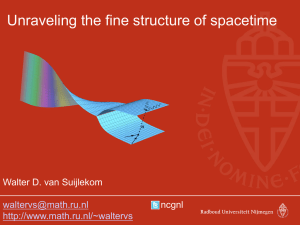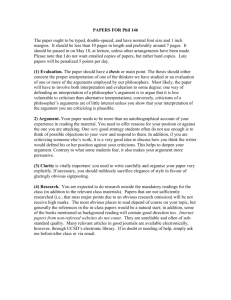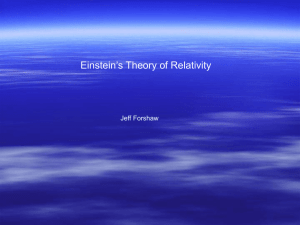General Relativity
advertisement
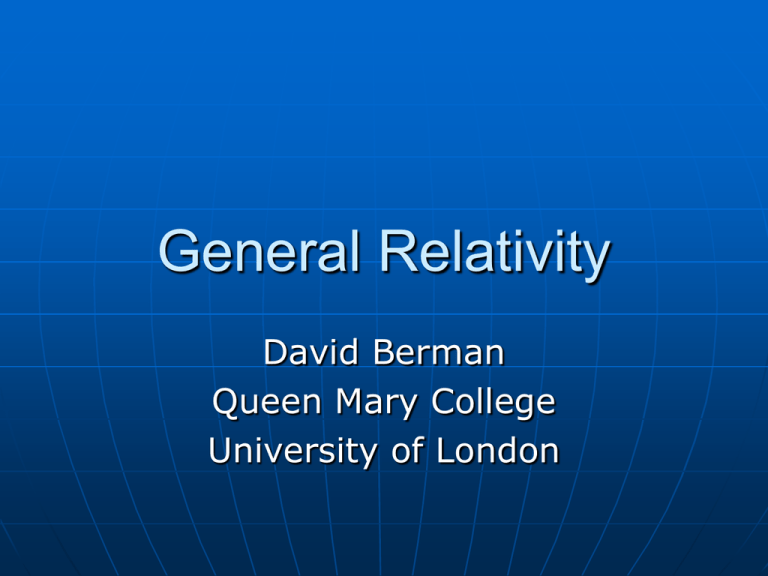
General Relativity David Berman Queen Mary College University of London Geometry In the previous lecture we saw that the important thing was to have an invariant quantity (the distance in spacetime). Remarkably the distance in spacetime involves changing how we add up the distance in space with the distance in time. s d t 2 2 2 Geometry Actually there are many ways we can add distance depending on the coordinates that we use. Consider using polar coordinates r- radial distance from the origin and an angle say theta. Geometry Polar coordinates d r r 2 2 2 2 r r Geometry Suppose we restrict ourselves to the circle. Distances on the circle would be given by theta only but the actual distance would be given by: d r 2 2 2 Geometry The point is, on a curved surface how you measure distance may not be as simple as we’ve seen so far. There are many things that change once we are on a curved space. Imagine the surface of the earth. Geometry Changes in geometry: To understand geometry we need to understand what makes a straight line on a curved space. A straight line between two points is given by the shortest distance between those two points along the curved surface. Geometry See how this can work on a curved surface. On the surface of a sphere the shortest distance between two points always lies on a great circle. This is what we mean by a straight line. Geometry How does geometry change when we are on a curved surface? The things we are used to: Angles of a triangle add up to 180 degrees. Pi is the ratio of the circumference to the diameter of a circle. Parallel lines never meet. Geometry In curved space: Parallel lines may meet in curved space The angles of a triangle do not add up to 180 degrees. The ratio of the circumference of a circle to its diameter is not Pi. Geometry All the information about the curvature of the space is in how we add up distances: Given: d f ( x, y)x g ( x, y)y 2 2 2 One can work out how all the other geometric properties. General Relativity We saw in special relativity: s d t 2 2 2 We’ve seen that in curved spaces how you combined distances can change. Can they change in spacetime? General Relativity Spacetime can curve. It can bend and its geometry can change just as on a curved surface. Spacetime distance will no longer be given by our favourite formula but by something more general. General Relativity s f (t , x, y, z )t g (t , x, y, z )x 2 2 h(t , x, y, z )y k (t , x, y, z )z 2 2 2 General Relativity What makes spacetime curve? Mass and energy make spacetime curve. The more mass and energy the more the geometry of spacetime curves and is affected. General Relativity How do objects more on curved a space. They move in straight Lines. That is they move so as to minimise the distance travelled. That is the shortest distance in between two points. This is like the straight lines we had on a sphere they bend when compared to flat space. General Relativity How do we interpret this physically? The shortest path between two points is how any particle will move. This is called a geodesic. Anything moving will follow a geodesic path. General Relativity This moving along geodesics explains how things move in a gravitational field. Mass bends spacetime. Objects in curved spaces move on bent trajectories. Therefore objects with mass cause other things to move on curved trajectories. This is a lot like gravitation. General Relativity In fact it is gravitation. Einstein realised in 1915 that this is what gravity is. Mass bends spacetime and objects move in spacetime along geodesics. Thus mass effects how objects move though bending spacetime. That is gravity. Light also follows geodesics. General Relativity Just like we had with special relativity where most the speeds we are used to are small, most spacetime curvatures are also small. There are places where spacetime curvatures are large, near very massive objects. These are black holes. Black holes We have learned that light itself follows geodesics. It bends according to the curvature of the spacetime. There are regions where spacetime is so heavily bent that light itself cannot escape that is a black hole. Bending of spacetime Space and time distort near very heavy objects. The following animations show how this happens. Speeds appear slower far away since time appears to slow down far away when compared to when you are close. Bending of spacetime Bending of spacetime Bending of spacetime Black holes Black holes form when there is enough mass to collapse spacetime and prevent light from escaping. This shows the spacetime bending as a star collapses creating a gravitational field strong enough to trap light. Black holes Black holes Black holes have been observed: Consequences Curving spacetime is something we also see in more ordinary circumstances. GPS satellite positioning system has to correct for general relativistic effects or else it would be wrong by 200 meters per day. Conclusions Spacetime is one thing It can bend, its geometry can alter like the surface of a rubber sheet The bending is described mathematically by: s f (t , x, y, z )t g (t , x, y, z )x 2 2 h(t , x, y, z )y k (t , x, y, z )z 2 2 2 Conclusions Once spacetime can bend we have to consider new geometries. Objects travel on geodesics in spacetime that is the shortest path. That is gravity. This can lead to things like black holes where spacetime bends so much light can’t escape. Conclusions Spacetime is a rich varied place where time and space bend in beautiful and miraculous ways. We must be amazed that we can imagine so much that is distant from our usual everyday view of the world; and it exists in the universe around us.
